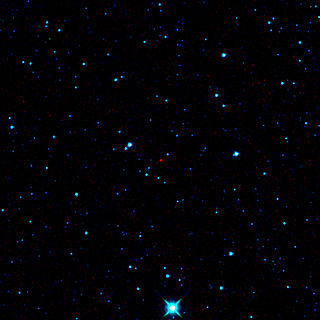 W
W2010 AB78 is a dark asteroid on an eccentric orbit, classified as near-Earth object of the Amor group. It was first observed by the Wide-field Infrared Survey Explorer (WISE) on 12 January 2010. The asteroid measures approximately 1.7 kilometers in diameter and has a low albedo of 0.03, which is rather typical for carbonaceous asteroids.
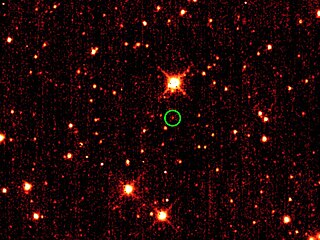 W
W2010 TK7 is a sub-kilometer near-Earth asteroid and the first (and only) Earth trojan discovered to date; it precedes Earth in its orbit around the Sun. Trojan objects are most easily conceived as orbiting at a Lagrangian point, a dynamically stable location (where the combined gravitational force acts through the Sun's and Earth's barycenter) 60 degrees ahead of or behind a massive orbiting body, in a type of 1:1 orbital resonance. In reality, they oscillate around such a point. Such objects had previously been observed in the orbits of Mars, Jupiter, Neptune, and the Saturnian moons Tethys and Dione.
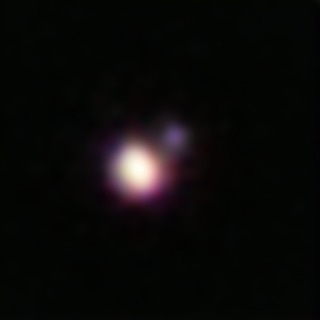 W
WCFBDSIR J145829+101343 is a binary system of two brown dwarfs of spectral classes T9 + Y0 orbiting each other, located in constellation Boötes about 104 light-years away from Earth.
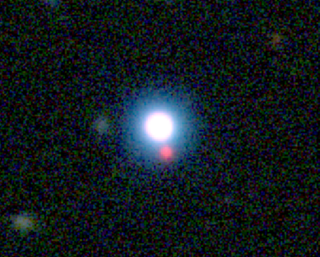 W
WGD 165 is a system of a white dwarf and a brown dwarf of spectral types DA4 + L4, located in constellation Boötes at approximately 103 light-years from Earth. GD 165 B remained the only brown dwarf companion of a white dwarf until the discovery of GD 1400 B, which was discovered 17 years later.
 W
WLuhman 16 is a binary brown-dwarf system in the southern constellation Vela at a distance of approximately 6.5 light-years from the Sun. These are the closest-known brown dwarfs and the closest system found since the measurement of the proper motion of Barnard's Star in 1916, and the third-closest-known system to the Sun. The primary is of spectral type L7.5 and the secondary of type T0.5 ± 1. The masses of Luhman 16 A and B are 33.5 and 28.6 Jupiter masses, respectively, and their ages are estimated to be 600–800 million years. Luhman 16 A and B orbit each other at a distance of about 3.5 astronomical units with an orbital period of approximately 27 years.
 W
WPSO J318.5−22 is a rogue planet, an extrasolar object of planetary mass that does not orbit a parent star. It is approximately 80 light-years away, and belongs to the Beta Pictoris moving group. The object was discovered in 2013 in images taken by the Pan-STARRS PS1 wide-field telescope. PSO J318.5-22's age is inferred to be 12 million years, the same age as the Beta Pictoris group. Based on its calculated temperature and age, it is classified under the brown dwarf spectral type L7.
 W
WStein 2051 is a nearby binary star system, containing a red dwarf and a degenerate star, located in constellation Camelopardalis at about 18 ly from Earth.
 W
WWISEPC J045853.90+643451.9 is a binary system of two ultracool brown dwarfs of spectral classes T8.5 and T9.5, respectively, located in constellation Camelopardalis at approximately 47 ly from Earth.
 W
WWISE J053516.80−750024.9 is either a sub-brown dwarf or a free planet. It has spectral class ≥Y1 and is located in constellation Mensa. It is estimated to be 47 light-years from Earth. In 2017, more accurate analysis found it to be a binary system made up of two substellar objects of spectral class≥Y1 in orbit less than one astronomical unit from each other.
 W
WWISE 1541−2250 is a sub-brown or brown dwarf of spectral class Y0.5, located in the constellation Libra at approximately 18.6 light-years from Earth. This object received popular attention when its discovery was announced in 2011 at a distance estimated to be only about 9 light-years, which would have made it the closest brown dwarf known.. It is not the farthest known Y-type brown dwarf to Earth.
 W
WWISEP J180026.60+013453.1 is a brown dwarf of spectral class L7.5, located in constellation Ophiuchus at approximately 29 light-years from Earth.
 W
WWISE 1828+2650 is a brown dwarf or rogue planet of spectral class >Y2, located in constellation Lyra at approximately 47 light-years from Earth. It is the "archetypal member" of the Y spectral class.
 W
WWISE J080822.18-644357.3, also called J0808, is a 45+11−7 Myr old star system in the Carina constellation with a circumstellar debris disk orbiting an M-type red dwarf about 331 lightyears from Earth.
 W
WWISE 0855−0714 is a sub-brown dwarf 2.23±0.04 parsecs from Earth, the discovery of which was announced in April 2014 by Kevin Luhman using data from the Wide-field Infrared Survey Explorer (WISE). As of 2014, WISE 0855−0714 has the third-highest proper motion after Barnard's Star and Kapteyn's Star and the fourth-largest parallax of any known star or brown dwarf, meaning it is the fourth-closest extrasolar system to the Sun. It is also the coldest object of its type found in interstellar space, having a temperature in the range 225 to 260 K.
 W
WWISE J224607.57−052635.0 (or W2246−0526 for short) is an extremely luminous infrared galaxy (ELIRG) which, in 2015, was announced as the most luminous known galaxy in the Universe. The brightness is 350 trillion times that of the Sun (349×1012L☉), and the merger of smaller nearby galaxies may be contributing to its brightness. The light is generated by a quasar 10 billion times the mass of the Sun. The optical and ultraviolet light emitted by the accretion disc around the quasar's supermassive black hole is absorbed by the galaxy's dust and remitted in the infrared. The galaxy releases 10,000 times more energy than the Milky Way galaxy, although WISE J224607.57–052635.0 is the smaller of the two. WISE J224607.57–052635.0 has a light-travel distance of 12.5 billion light-years from it to Earth. The galaxy was discovered using the Wide-field Infrared Survey Explorer.
 W
WWISEA 1101+5400 is a T-type brown dwarf approximately 100 light-years away in the constellation Ursa Major. It was discovered in March 2017 by members of the citizen science project Backyard Worlds. Initial photometric analysis suggested it was a T5.5 dwarf, which was later confirmed by a spectrum of the star, obtained with the NASA Infrared Telescope Facility. It is the first confirmed brown dwarf found by the project.
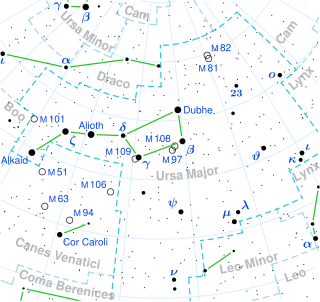 W
WXi Ursae Majoris, also named Alula Australis, is a star system in the constellation of Ursa Major. On May 2, 1780, Sir William Herschel discovered that this was a binary star system, making it the first such system ever discovered. It was the first visual double star for which an orbit was calculated, when it was computed by Félix Savary in 1828. It is also a variable star with a small amplitude. Xi Ursae Majoris is found in the left hind paw of the Great Bear.